My journey as a Bachelor of Creative Technology student at AUT
Don't wanna be here? Send us removal request.
Text
ENEL599 - Assignment 2 Demonstration Media
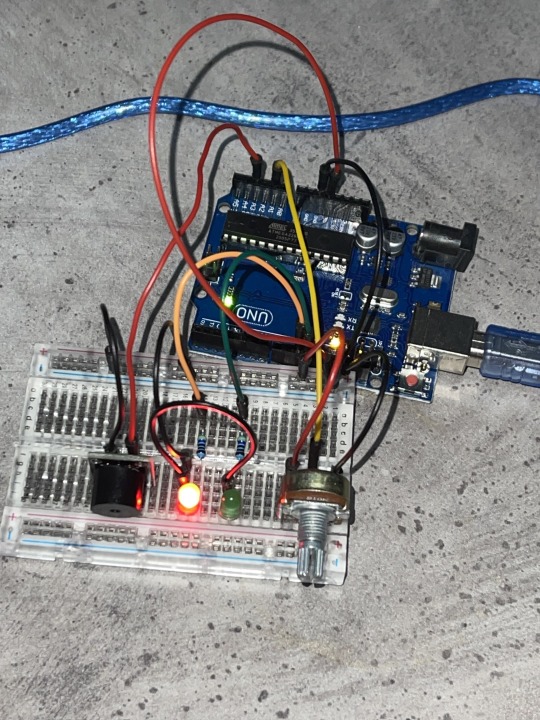
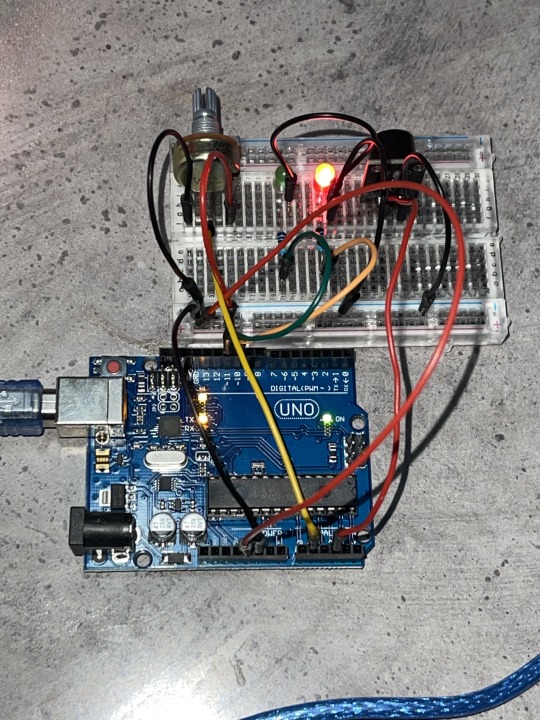
Wire Colours:
- Red: 5V
- Black: Ground
- Yellow: Potentiometer Signal
- Green: Green LED
youtube
0 notes
Text
ENEL599 - Assignment 1 Demonstration Media
Photos
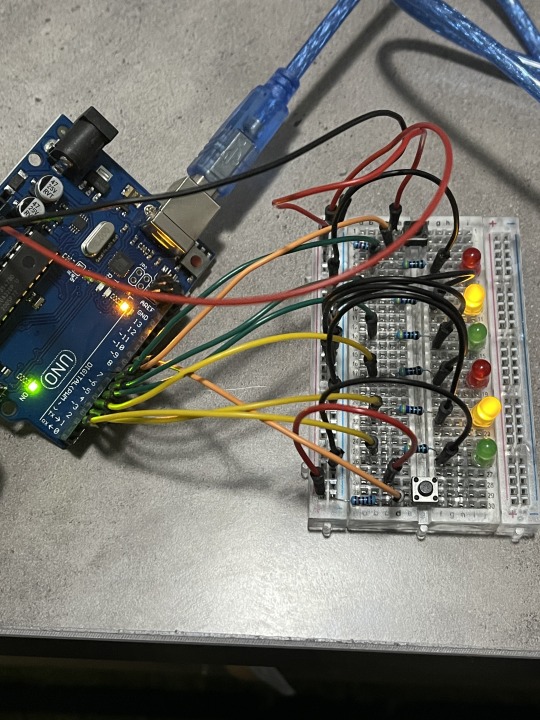
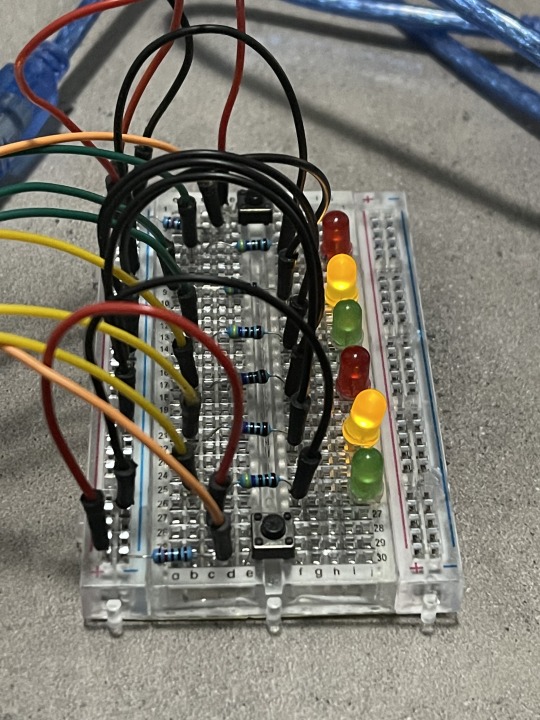
Video
youtube
Wire Codes:
Red = 5V
Black = Ground
Orange = Button
Green = Traffic Light Set 1
Yellow = Traffic Light Set 2
0 notes
Text
Funnily enough, this is exactly how I am going about my pitch feedback...
"I'm planning to fix this technology problem... by... (wait for it) adding more technology to the problem"
Genius.

3 notes
·
View notes
Text
Week 7/8 Reflection - Effectuation Logic
Week 7 taught us about Effectuation Logic.
Effectuation Logic is logic solely based on the act of envisioning what can be possible given what is available. There are a few principles to this logic such as the Bird in Hand Principle, Affordable Loss Principle, Lemonade Principle, Crazy-Quilt Principle and Pilot in the Plane Principle. The specific principle that came into play this week was the Lemonade Principle.
The Lemonade Principle encourages you to change your view on failures, to utilise the unpredictable and overall learn from the events or things you have perceived as a ‘fail’. This week’s ‘failure’ was my project pitch. My group and I had pitched our idea to our class peers and some of the teaching staff but our idea’s lack of originality and uniqueness caused a lacklustre response. They gave us helpful feedback on the idea but ultimately brought us to the conclusion that we need to go back to the drawing board.
Admittedly, I was taken back a few steps at first. It was discouraging to be told an idea you were so passionate and excited about was actually not that great. I knew that what I was feeling was valid and reasonable but I also knew that it wasn’t productive to be stuck feeling like that. This whole semester, our studio and ICT lessons have told us that failure isn’t a bad thing and I have come to realise that more.
The Lemonade Principle especially resonated with me. I thought to myself, instead of seeing this as a failure I should see it as a challenge. The main feedback given was that our idea could easily be reproduced with equipment that everyone already has so our idea wasn’t very practical. So, instead of changing the idea completely, I am going to challenge myself. My next step is to further develop my idea into something that cannot be reproduced so easily. At this point in time, I don’t know if that is possible but I have hope that it is. This form of thinking is actually applicable to the other principle, Bird in Hand. I am taking action based on who I am and what I know and have been told as opposed to going back to the drawing board and looking for some new inspiration.
Through the use of Effectuation Logic, I am able to create a strong entrepreneurial mindset and fully explore my ideas before changing to a new one - leaving no stone unturned. In a way, for me at least, Effectuation Logic is a shield that protects me from going insane from external factors and failures while also keeping a level-headed view on the project at hand.
3 notes
·
View notes
Text
Week 6 - Reflective Post
How is my creative process changing?
My original method of thinking was very solution-first thinking - I would think of a product and then think about what it solved afterwards. This was helpful in the sense that it got me thinking about some innovative ways to utilise some of the technologies we already use but often the end result would lack proper purpose. I know this is a different way of doing it but it gives a bit of context to how much my creative process has changed just 6 weeks into this course.
Last week’s task for our studio was to develop an idea for us to pitch this week. We were first given a brief and then given the freedom to choose our own problem. I slowly narrowed my topic field from Mental Health to seasonal depression (also known as Seasonal Affective Disorder). Using systems thinking, I was able to see all the effects the disorder has on a person, ranging from personal issues to problems in the workplace. This way of thinking helped me to develop a realistic solution for my project. Thinking this way was almost the complete opposite of my ‘solution-first’ technique but I feel like it lead to a much more developed and realistic end result with a proper purpose.
Experience of having an idea in my mind and growing it in the real world.
As seen in my recent studio projects, such as the horror sound instrument and ‘hack a board game’ project, I have little experience in growing my ideas in the real world. However, I do know it is a learning process and I can see from my reflective posts that I am aware of the next steps required which is definitely a nudge in the right direction. From practising developing these little ideas, I have the opportunity to develop my practical skills which will further benefit my creative process.
What topics am I developing more nuanced views on?
My views on practical learning is slowly changing as this course progresses. Throughout high school and even in my first attempts at university, I have been practising mostly theory-based learning and was lead to believe that this form of learning is far more superior to practical. As I get more hands-on experience while developing these ideas, I am able to better strengthen and understand some of the theory and ideology behind it. As mentioned above, by using systems thinking in a ‘real-world’ scenario where I’m developing an idea, I am able to think of and answer questions that I would have otherwise not thought about.
What are some things I learnt this week?
Technological Determinism was introduced to us last week but discussion carried over to this week. This is the belief that our society, beliefs and habits are shaped by the technology that surrounds us - practically taking the power away from the people. In reality, it is the people that hold the power as we are the ones that create such technology to suit our needs and habits that already exist or are preferential.
A way to think about this is, the technology created is no more than the person/group that created it. An example of this was mentioned in class today where it was found that most facial recognition technology has a bias to where Black females would be less likely to have a successful recognition rate.
I can now see the ethical issues behind...
Facial recognition for law enforcement. This was also discussed in class but after further research I found that Black people are overrepresented in mugshots which could lead to them being more likely to be convicted for minor crimes than a White person. These mugshots are then used by facial recognition software to identify people committing crimes. An example being NYPD has over 40,000 mugshots (92% of them being Black or Latinx) due to ‘gang affiliation’ yet there is no proof needed for a person to be considered affiliated. This obviously isn’t the technologies fault but the people who created it and their lack of insight or consideration of all races and ethnic groups.
1 note
·
View note
Text
Am I learning anything? (Discussion Post)
Today’s lesson was definitely an eye-opener. I want to start this post by mentioning the fact that I have not been trying my hardest when it came to ICT. I would come to class, listen and not do anything with that knowledge which ultimately caused me to forget almost it all.
In all honestly, I thought I didn’t need to know any of it, I didn’t understand the purpose of the knowledge in terms of my future and my career. Don’t get me wrong it all seemed interesting (and it very much is) but I thought, we’re not being tested on this specific knowledge therefore I don't need to retain it. It wasn’t until Ricardo called us out, that I realised that is a terrible way of thinking. Though, I guess I can take some of the blame away from myself as the current academic system only really taught us to cram information with the sole purpose of passing a test rather than using the knowledge in practical ways.
This post to me will serve as a type of contract that I am signing. A contract with the purpose of keeping a promise to myself as my behaviour and habits directly affect my career path.
From here on, I will ensure to put in the necessary time each week for this course. I will take how ever long it takes for me to understand the terminology and ideology mentioned in class through readings, videos and notes taken during the class discussion. Most importantly, I will ask questions as asking questions will help me better my knowledge and can spark discussions which can benefit the class as a whole.
Hopefully this isn’t just a random burst of energy, I guess time will tell.
2 notes
·
View notes
Text
Week 3: Sound - The soundboard from hell
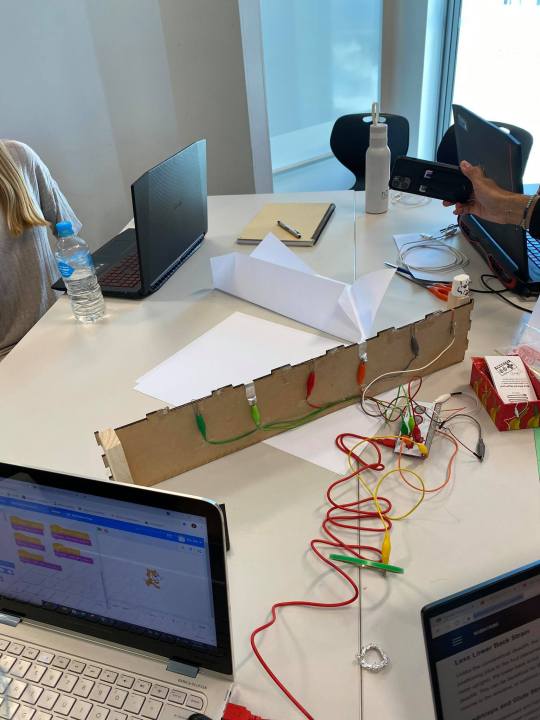
The topic for this week was sound and its emotional power. We were instructed to create an instrument that utilises sound to invoke emotion. For this, we used the Makey Makey and Scratch. Scratch is a block-based programming language with a visual interface.
We chose to create an instrument which was a soundboard for horror films. Horror films heavily rely on sounds to immerse the viewer in the universe it creates and to heighten the fear of its viewers. We tried to find sounds that represent the three types of auditory icons: Iconic/Nomic, Symbolic and Metaphorical. We landed on the following sounds;
- Iconic sounds: Metal ‘Shing’, Knife scrapping, Insects, Blood spilling, creaking door
- Symbolic sounds: Ghost breathing
- Metaphorical sounds: Startled bells
The final product was intended to be used like a soundboard/piano type instrument where you press a key, and it would make a sound. Unfortunately, it was not very obvious how to use it. As we got people to test it, they were unsure how it was meant to be used as there were no labels or obvious buttons. In future, I believe it would be more intuitive if, along with labels, there was tactile feedback when a button was pressed as opposed to the flat surface we had used.
I believe we had chosen a good variety of sounds to portray the emotion of fear that would be communicated in a horror film. Regrettably, our design was lacklustre and hard to understand. Future improvements in our creation process would be to better organise our time and individual efforts in order to be more efficient.
1 note
·
View note
Text
Week 2: Papertronics and Makey-Makey

Our first task was to create a basic paper circuit to power a single LED. The materials we used were a paperclip for the switch, conductive tape as a connection between the components, a button cell battery and an LED. This was an interesting exercise as it showed us some of the limitations of a paper circuit; the limitations being, the underside of conductive tape is less conductive than the top due to the glue and sometimes the bending of the paper can weaken the connections. We did find that these issues can be rectified by reinforcing the paper to make it stronger as well as double stacking the tape (which we used in the next exercise).
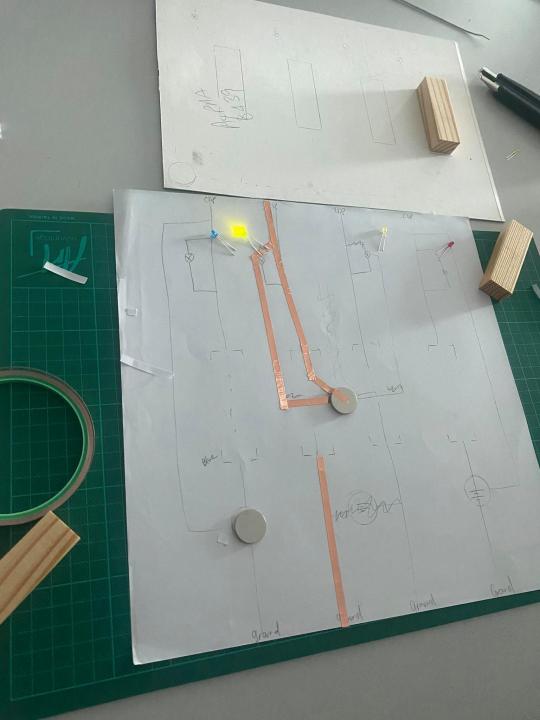
We were then introduced to Makey Makey which is a kit that allows for creative electronic inventions. After being introduced to this kit, our next task was to ‘hack’ a pre-existing board game and to make it more interactive. After looking at the possible options, we chose Jenga as it was a basic game that allowed us to be as creative as possible and interpret new ways to play it. We decided it was best to stick with the materials we had already practiced with as we were aware of the weakness and with the given timeframe, it was most practical. We collectively agreed that to make the game more interactive, we would need to add more steps to the game to allow for more user input and a more gratifying endgame.
To make the game more interactive, we decided to use the blocks as switches to complete a circuit and win the game. Our original idea was to use LEDs as an indicator that the correct piece was placed, but after further experimenting, we decided that was less efficient and did not utilise the Makey Makey. We finally settled on having a program that prompts the user to input their ‘password’ as this allowed for instruction in case the user was not clear on the process.
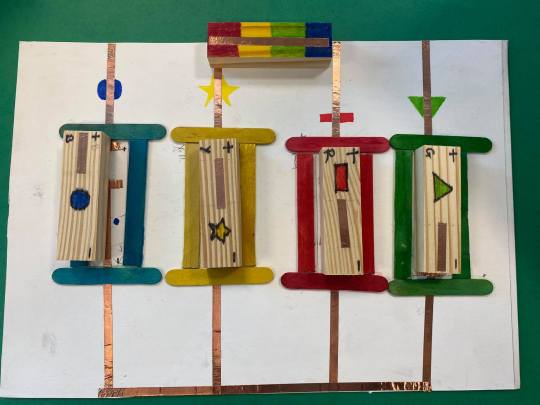
We realised that simply using blocks to complete a circuit may be too easy, so we introduced different types of blocks (as seen in the picture) and made it so they needed to be put in a specific order. We labelled each switch and its coinciding place in the circuit with matching colours and shapes. We believe that the matching elements would serve as good entry points for the user to better understand how to play the game.
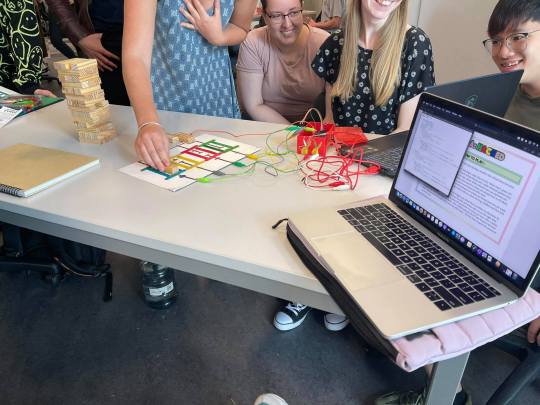
I think our game was very intuitive and playable for everyone. The colours allowed for younger players to play and the shapes allowed for colour-blind players. As a group, we were able to come together to overcome the limitations we discovered with the components and our original ideas. If this were to be developed further, I believe we could implement more components like the LEDs and have a less finicky board as sometimes the circuit wouldn’t recognise the block was placed down unless it was pressed hard.
1 note
·
View note
Text
CTEC502 - Creative Tech Vlog
Our first assignment was to create a 4 minute vlog explaining my path to creative technology and how I envision my future within the industry. This was my take (Which ended up being a bit longer than 4 minutes but I had a lot to say and 4:30 minutes was the best I could do hehe).
youtube
Transcript:
Everyone has a life, it is what we do with it, as individuals, that makes us unique and gives us the possibility to create a meaningful impact in our society and even the wider world
Kalimera, Talofa Lava, Hello. My name is Elias Kaleta and I am currently studying a bachelor of Creative Technologies at Auckland University of Technology. I have travelled a long path to end up to where I am today; A path that ranges from studying English and Media, Film & TV to Psychology and Computer Science. I studied most of these things because I thought they were, “tried and true” career paths where I would go right through it and have a job lined up. The issue was, I wasn’t passionate about it. Throughout high school and my first attempts at university, I would do great at the practical aspects but when it came to exams, I struggled. I find myself to be a very hands-on and kinaesthetic learner but the current educational system forced me to think that theoretical learning was the only way I could succeed in my chosen career path. After all these failed attempts at learning, I realised that maybe it wasn’t the content that I wasn’t enjoying, but the way that it was delivered. So I decided it was time for a new environment and four weeks into Creative Technologies at AuT and I can already tell things are different..
When I first enrolled into Creative Technology last year, my friends and family bombarded me with the question, ‘What is Creative Technology?”, and I would always respond, “It’s like a mix of design and computer science”. It wasn’t until recently I realised that couldn’t be more wrong of an answer. Sure, to some extent it encompasses elements of design and computer science, but creative technology is so much more than that. A generic but truthful answer, is that it is a multidisciplinary course which gives one the skillset to look at one issue through many different viewpoints. You see, at first Creative Technology seemed like such a hard thing to describe when all along, it was right there in the name, “Creative. Technology.”. It’s about finding new, creative and innovative ways to utilise pre-existing technology in our work, our art and just our lives in general. An example (though it may seem like an odd one), would be the issue of brushing your teeth in the morning and having a coffee ready for work; why do one at a time when you can do both? Create a toothbrush that when it is being used, it turns on your coffee maker so it is ready for you once you’ve finished the classic 2 minute brush. Okay, that may be a bad idea but I’m learning that, that’s okay. Bad ideas actually don’t exist, they’re all a part of the creative process which leads to better and more complex ideas.
A reason why Creative Technology is so unknown, is because it’s a rather new term. In 1993, Bran Ferren was one of the first people in the cooperate world to be given the title of a ‘Creative Technologist’ as a part of the Walt Disney Company. Disney’s CEO, Michael Eisner, relayed a message from Ferren which was that his broader mission, “…is to dream about the future and to show us new and innovative ways to tell stories.” [1] something I think perfectly describes the mindset a creative technologist should have. Ferren then went on to work on many different projects within the Walt Disney Company such as; Some amusement park rides like the Tower of Terror ride and the Indiana Jones Adventure ride, as well as many on-air television projects.
Now, Creative Technology is changing everything. An example of this is the way companies are marketing their products; companies like Coca Cola. Coca Cola has used technology to allow the consumer to interact with the company right from their phones with their ‘Sip and Scan’ campaign that allows the consumer to scan their bottle and win prizes. They have also implemented different interactive activities around the world like in Japan, where someone can play a dance-dance-revolution type game in order to receive a free coke can. [2] It is ideas like this, that make me excited to pursue a career in Creative Technology.
I’m hoping that this course will give me the opportunity to expand on my creative thinking and that it will supply me with the knowledge and direction to finetune my practical and mental skills. I want it to challenge me to criticise the way we use technology in our lives and find ways to change it for the better.
I have had a long, tiring path up to this point, but I finally feel like I have direction and that my career in Creative Technology will consist of projects that will benefit my society, my country, or even more eagerly, the world.
Resources:
[1] - https://variety.com/1999/biz/news/ferren-heads-r-d-tech-at-imagineering-1117492140/
[2] - https://www.digitalsignagetoday.com/articles/coke-launches-dance-dance-revolution-in-s-korea-with-digital-signage-kiosk-video/
Photo Credit: https://www.dreamstime.com/photos-images/happy-work.html
Photo Credit: https://patrickbryan.design/coca-cola-sip-n-scan
1 note
·
View note
Text
Systematic Thinking with Loopy
This week we were challenged to start practicing Systems Thinking. Our task is to take a more holistic view towards some of the technological systems we encounter in our everyday life. In order to do this, we must take all the elements of a certain system and see how they are linked and react with each other to create a whole functioning system.
We were introduced to a web tool named Loopy by Nicky Case. This tool helps us recognise these systems and the way their elements interact with each other. I chose to look at electric vehicles and the impact it has on the vehicle industry as well as it’s environmental impact.
Link to my Loopy: http://bit.ly/38miN2K

1. What is the event/thing you have chosen?
I chose electric vehicles. Electric vehicles (EVs) are the automotive industry’s answer to the rising issues of climate change. They use electricity as the sole energy source to run the motor as opposed to the more traditional method which relies on fossil fuels. This vastly reduces the vehicle’s carbon footprint.
2. Patterns - What are the patterns/habits associated with that event/thing?
As you can see in the loopy above, many factors are affected and affect electric vehicles. As our society attempts to decrease their carbon footprint, electric vehicles are growing in popularity (along with its cheaper-to-maintain nature). Unfortunately, there is still a ‘premium’ on these vehicles meaning they are more expensive than a typical petrol vehicle, making EVs a less realistic option for lots of consumers. Fortunately. the Ministry of Transport is making moves to make these cars more accessible and affordable.
There is also the notorious saying, ‘Old habits die hard’ which, in this case, is petrol cars. It is common for an EV to have less power than a standard petrol car and are also known to ‘feel different’ to drive. Everyone is used to driving a petrol car and trying something new just is not everyone’s cup of tea. This also comes with the issue that there are not many mechanics offering services for electric vehicles as it is still a relatively new concept to most - thus making it more difficult for consumers to get their car serviced, should they need it.
3. Structure - What has influenced the patterns?
According to New Zealand’s Ministry of Transport, transport contributes 21% of the greenhouse gas emissions to our country’s annual total, with road transport emissions doubling between 1990 and 2018. Light vehicles (Vehicles that have an engine capacity of >1.5) make up 70% of the transport total[^1]. Electric vehicles are the automotive industry’s answer to the rise in the climate change movement. The transition has been rather fast in terms of technological advancements; it has slowly improved from fuel-economical cars to hybrid vehicles (cars that use electric and petrol), to electric vehicles. The increasing threat that climate change has on our planet is forcing these industries to adapt and change their products to fit a more environmentally friendly world.
Resources:
[^1] https://www.transport.govt.nz/area-of-interest/environment-and-climate-change/climate-change/
2 notes
·
View notes